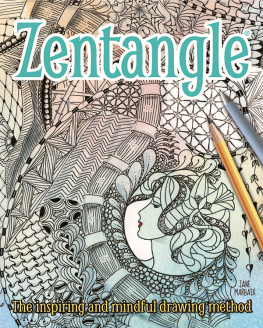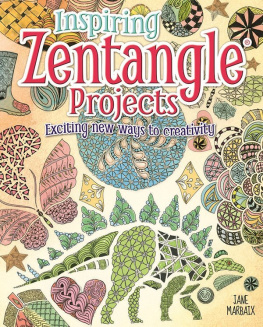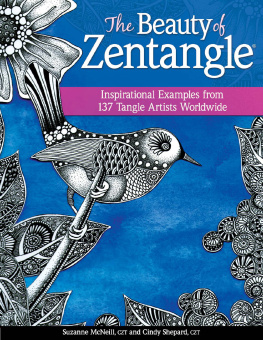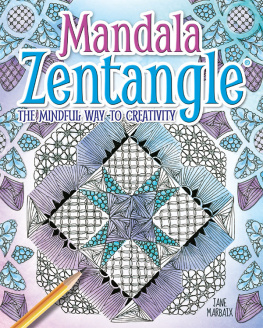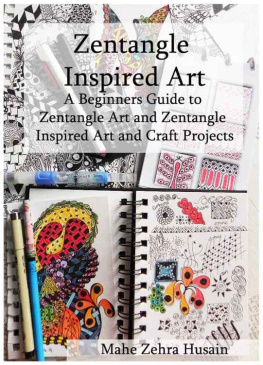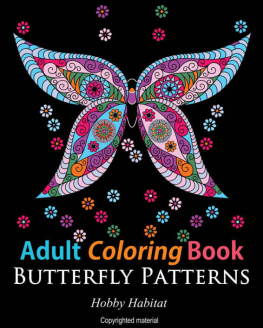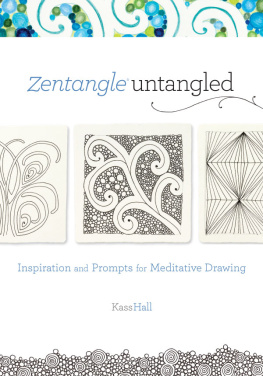I would like to thank my friend Jamie Malden of colouricious.com, who told me about Zentangle and organized my early workshops at her home; and Rick Roberts and Maria Thomas, who taught me a skill for life.
Zentangle, the Zentangle logo, Anything is possible one stroke at a time, Bijou, Certified Zentangle Teacher, CZT, Zentangle Apprentice, and Zentomology are trademarks, service marks or certification marks of Rick Roberts, Maria Thomas and/or Zentangle, Inc.
PERMISSION TO COPY ARTWORKS: The written instructions, designs, patterns and projects in this book are intended for the personal use of the reader and may be reproduced for that purpose only. Any other use, especially commercial use, is forbidden under law without the written permission of the copyright holder.

This edition published in 2015 by Arcturus Publishing Limited
26/27 Bickels Yard, 151153 Bermondsey Street,
London SE1 3HA
Copyright Arcturus Holdings Limited
All rights reserved. No part of this publication may be reproduced, stored in a retrieval system, or transmitted, in any form or by any means, electronic, mechanical, photocopying, recording or otherwise, without prior written permission in accordance with the provisions of the Copyright Act 1956 (as amended). Any person or persons who do any unauthorised act in relation to this publication may be liable to criminal prosecution and civil claims for damages.
ISBN: 978-1-78428-164-9
CONTENTS
What is Zentangle?
The Zentangle Method is an easy-to-learn, relaxing, and fun way to create beautiful images by drawing structured patterns.
These are the words of Zentangles creators, Maria Thomas and Rick Roberts. Maria is a talented lettering artist and Rick is the zen of the partnership, having lived as a monk for 17 years. Rick noticed that while Maria was working at her art she was in a very calm state, totally focused on what she was doing. They set about breaking down the patterns they created in an easy-to-follow format so that anyone artist or not could create beautiful images by repeating the patterns. Thus the Zentangle Method was born.
Anything is possible, one stroke at a time has become a Zentangle slogan part of a philosophy that has brought the benefits of the exciting art form that is Zentangle to many people. My own adventure with it began when I went to the USA to study with Rick and Maria. I was intent on getting the most out of Zentangle for myself, but the realization that my enjoyment of it could be shared led me to start teaching it in classes and workshops.
Zentangle is more than just a form of art it helps to release stress, is very calming and offers enormous pleasure. The aim of this book is to show that the Zentangle Method is easy to learn and that lovely results can be achieved even if you have no drawing skills Zentangle has a happy knack of bringing out the artist in everyone. One of the keys to Zentangle art is always to take your time go slowly and relax. The focus is on the present moment, never on the result; on the journey, not the destination.



Zentangle art is created on a tile which is 9 cm (3 in) square. The official Zentangle tile, which is undoubtedly the best, is created from Fabriano Tiepolo paper (available from good art shops and also online). Some tanglers just use a good-quality card stock, as I have done for this book.
You can begin making tangles (patterns) with just a soft pencil, an 01 (0.25 mm) black pen (Sakura Pigma Micron are the best I have used), and a blending stump. You might also like to have an 08 (0.50 mm) pen or a Pigma Graphic 1 for the darker areas. I also use stencils, rubber stamps, protractors and a compass for larger pieces; anything bigger than 9 cm (3 in) square is categorized as Zentangle Inspired Art (ZIA). A good starting point is the kit available from www.zentangle.com. It comes in a handcrafted box containing everything you need, including a DVD with a demonstration by Maria.
Try to set aside some time each day to practise the tangles. I always take a little blank-page notebook (I love Paperblanks) and a pencil and pen with me wherever I go, just in case I get an opportunity.
Zentangle art is suitable for all ages from about four years upwards. It is very calming for children to have time set aside to tangle, and it improves their concentration and handwriting as well. The oldest student I have had was 97. Zentangle really does make a difference to everyone who tries it.

First steps
In the Zentangle Method, tangles (patterns) are broken down into simple steps so that it is easy to re-create each tangle. Each tile (or square) is divided into spaces and each space will have a different tangle in it. There are many tangles to choose from. In the tiles below, Crescent Moon, Static, Tipple and Florz are used, all of them original Zentangle patterns created by Rick Roberts and Maria Thomas. Most of the tangles in this book are Rick and Marias original tangles, because they are deconstructed for you to follow in the simplest way possible and are therefore ideal for beginners. In time you may be able to create your own tangles, but for now follow the steps and experiment with drawing strings or shapes on the tiles to see what interesting images can emerge.
Tile No. 1 with Z string
We shall start by doing two tiles with set patterns to make it easy for you to follow.

Pick up your pencil and draw a dot in each
corner of your tile.

Join the dots up lightly with your pencil to form a border.
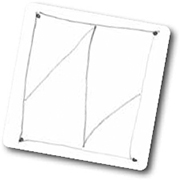
Draw a string (pencil lines that create spaces within the tile). Here we shall draw a string in the shape of a Z. Now take your pen (01 Sakura Pigma Micron black). Choose a tangle (pattern) and fill one of the spaces you have created the first tangle we are using is Crescent Moon, which is a good example of a halo (see the second illustration of the step out opposite). For each space on the tile, use a new tangle.
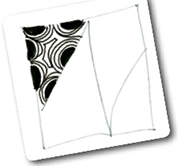
In the first space, draw Crescent Moon.

